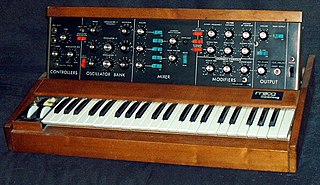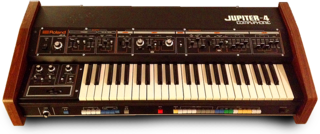
The Roland System 700 was a professional monophonic [1] modular synthesizer for electronic music manufactured by the Roland Corporation and released in 1976 and was followed by the Roland System-100M in 1978. [2]

The Roland System 700 was a professional monophonic [1] modular synthesizer for electronic music manufactured by the Roland Corporation and released in 1976 and was followed by the Roland System-100M in 1978. [2]
The System 700 range included the following modules: [3]
The following blocks were offered, as suggested combinations of modules:
The System 700 was used by many artists, including: [4]

An analog synthesizer is a synthesizer that uses analog circuits and analog signals to generate sound electronically.

Modular synthesizers are synthesizers composed of separate modules for different functions. The modules can be connected together by the user to create a patch. The outputs from the modules may include audio signals, analog control voltages, or digital signals for logic or timing conditions. Typical modules are voltage-controlled oscillators, voltage-controlled filters, voltage-controlled amplifiers and envelope generators.
The Yamaha AN1x is a DSP-based analog modeling synthesizer, produced by Yamaha Corporation from 1997 to 1998, and was marketed as an "analog physical modelling control synthesizer".

The Jupiter-8, or JP-8, is an eight-voice polyphonic analog subtractive synthesizer introduced by Roland Corporation in early 1981.
Doepfer Musikelektronik GmbH is a German manufacturer of audio hardware, mostly synthesizer modules, based in Gräfelfing, Upper Bavaria and founded by Dieter Döpfer. The product range covers analog modular systems, MIDI controllers, MIDI hardware sequencers, MIDI-to-CV/Gate/Sync Interfaces, MIDI master keyboards and special MIDI equipment.

The Realistic Concertmate MG-1 is an analog synthesizer manufactured by Moog Music in 1981 and sold by Radio Shack from 1982 to 1983 under their "Realistic" brand name. It was produced without some standard Moog features, such as pitch and modulation wheels, as a cost-cutting measure aimed at achieving a lower price for the consumer market. The synthesizer also featured a pair of pass-through RCA jacks, which allowed users to mix radio or records into the final live synthesized sound output.

The Roland Jupiter-4 (JP-4) was an analog synthesizer manufactured by the Roland Corporation between 1978 and 1981. It was notable as the company's first self-contained polyphonic synthesizer, and for employing digital control of analog circuits, allowing for such features as programmable memory, voice assignment modes, an arpeggiator, polyphonic portamento and others.

The Korg MS-20 is a patchable semi-modular monophonic analog synthesizer which Korg released in 1978 and which was in production until 1983. It was part of Korg's MS series of instruments, which also included the single oscillator MS-10, the keyboardless MS-50 module, the SQ-10 sequencer, and the VC-10 Vocoder. Additional devices included the MS-01 Foot Controller, MS-02 Interface, MS-03 Signal Processor, and MS-04 Modulation Pedal.

MOTM is the name of the modular synthesizer system manufactured by Synthesis Technology. MOTM is an acronym for "Module of the Month".

The Moog model 2090 Micromoog is a monophonic analog synthesizer produced by Moog Music from 1975 to 1979.
The Korg Polysix(PS-6) is a six-voice polyphonic analog synthesizer released by Korg in 1981. It was one of the first affordable polyphonic synthesizers on the market, and was released as a cheaper alternative to the Sequential Prophet-5 and Oberheim OB-X, priced at approximately a third of the cost of its contemporaries in the polysynth market. It includes one VCO per voice, enhanced by a chorus/ensemble effect for added richness. It also comes equipped with 32 program memories and an integrated arpeggiator.

DCB was a proprietary data interchange interface by Roland Corporation, developed in 1981 and introduced in 1982 in their Roland Juno-60 and Roland Jupiter-8 products. DCB functions were basically the same as MIDI, but unlike MIDI, DCB could provide note on/off, program change and VCF/VCA control only. DCB-to-MIDI adapters were produced for a number of early Roland products. The DCB interface was made in 2 variants, the earlier one used 20-pin sockets and cables, later switching to the 14-pin Amphenol DDK connector vaguely resembling a parallel port.

The Doepfer A-100 is an analog modular synthesizer system introduced by German audio manufacturer Doepfer in 1995. Although there were only 10 module types at time of release, it currently has more than 120 modules plus several different enclosures and accessories.
The Roland GR-500 is a guitar synthesizer. Manufactured by the Roland Corporation and FujiGen in 1977, it was one of the first guitar synthesizers.

The Serge synthesizer is an analogue modular synthesizer system originally developed by Serge Tcherepnin, Rich Gold and Randy Cohen at CalArts in late 1972. The first 20 Serge systems were built in 1973 in Tcherepnin's home. Tcherepnin was a professor at CalArts at the time, and desired to create something like the exclusively expensive Buchla modular synthesizers "for the people that would be both inexpensive and powerful." After building prototypes, Tcherepnin went on to develop kits for students to affordably build their own modular synthesizer, production taking place unofficially on a second floor CalArts balcony. This led to Tcherepnin leaving CalArts in order to produce synths commercially, starting in 1974.

The Oberheim Xpander is an analog synthesizer launched by Oberheim in 1984 and discontinued in 1988. It is essentially a keyboardless, six-voice version of the Matrix-12. Utilizing Oberheim's Matrix Modulation technology, the Xpander combined analog audio generation with the flexibility of digital controls logic.

The Roland System-100M was a modular analog synthesizer manufactured by the Roland Corporation in the late 1970s and early 1980s. It was the successor of the Roland System-100, a semi-modular keyboard.

The Polivoks is a duophonic, analog synthesizer manufactured and marketed in the Soviet Union between 1982 and 1990. It is arguably the most popular and well-known Soviet synthesizer in the West, likely due to the uniqueness of both its appearance and sound.
The Roland MKS-80 Super Jupiter is a rack mount sound module version of the Roland Jupiter-6 and the Roland Jupiter-8 synthesizers. It is an 8-voice polyphonic analog synthesizer that was manufactured by Roland between 1984 and 1987. It is the only one of the MKS series of synthesizers to have analogue voltage-controlled oscillators (VCOs) instead of analogue digitally-controlled oscillators (DCOs). The voice architecture is almost identical to the Jupiter-6 synthesizer. The service manual states that "The module board of MKS-80 features the following in addition to that of JP-6, its brother module. 1) HPF. 2) Low boost circuit in the 2nd VCA. 3) DC supply current boost circuit (IC50)."

The AX60 is a polyphonic analogue keyboard synthesizer manufactured by Akai Professional in the mid-1980s. It was Akai's answer to the popular Roland Juno series synthesizers. The AX60 uses voltage-controlled analogue oscillators and filter circuitry based on the Curtis Electronics CEM 3394 integrated circuit.